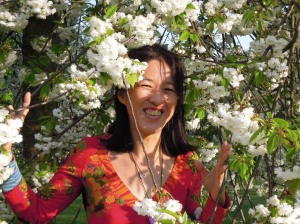
Rona wished to have this post published after her death. She started writing it while in ICU and never had the chance to finish it. She went back to her hospital room with intense pain and several other complications. On July 28th 2019 Rona was transfered to St Christopher’s Hospice.
Rona died in the morning of July 15th 2019.
Alison and myself were with her. She left peacefuly.
Rona was an extraordinary woman. She enjoyed this blog and made many friends in this space.
Thank you all for following her.
With love and gratitute,
Mireille & Alison
[here is the original blog post – it has several blank and place holder that are left as-is]
Last blog post (as at 31 May 2019)
A (premature) post
I never thought I would write this post. I thought this post would be written in years to come, but unfortunately, life isn’t like that. We try to control its events, but life is full of surprises.
So if you’ve been following this blog faithfully, I was alive recently, but now am dead.
The cancer got me in the end.
I was trying to drag out the blog posts, but events started galloping.
The gist of what has happened: In November 2018 I went to Peru to do intensive plant medicine work. I gave up my house of 22 years and took medical leave. I thought I was doing the right thing as plant medicine work had given me so much since 2014. I hadn’t realised how homesick I would be. And how naïve I was to place my faith in indigenous systems of medicine or a medicine practitioners which/who hadn’t really had much experience with cancer.
In March 2019 I returned after altitude sickness showed that I had fluid in the left lung. I had the lung drained twice in Peru and on returning saw my oncologist. My lung needed draining again. A scan showed that there was now cancer in the lung, liver and in the spine.
So I left in November 2018 with locally-advanced cancer, and relatively fit and lively, and returned with Stage 4 cancer.
To say I was overwhelmed is an understatement.
A procedure called pleurodesis was carried out in which the sides of the chest wall are scraped and a talcum powder applied. The theory was that the lung would expand and stick to the powder. And this would seal any gaps so any fluid would not accumulate. A nurse told me that there was a 35% chance the surgery wouldn’t work. Guess what … it didn’t.
A few days after the pleurodesis, I was dressing the wound and noticed pus in the suture site. So I went back to hospital and was immediately re-admitted for 5 days and intravenous antibiotics.
I was discharged and went back to stay with some friends. I returned the following week for the start of chemotherapy, but the lung required draining again, so I was hospitalised and 4 days later had my first session of chemotherapy, a taxol. The chemotherapy was to be administered on a weekly, rather than 3-weekly basis because my oncologist said that the heavier dose of the 3-weekly protocol would kill me.
That first session resulted in an infection. So I had to remain in hospital.
I was in hospital the following xx weeks. Each session of chemotherapy brought on an infection, or sepsis. My blood pressure went down dangerously low, my heart beat was permanently too fast (resting of 116) and I needed supplemental oxygen, and a drain in my lung.
I was also told the following: if a healthy person keeled over on the street with a cardiac arrest, CPR would have a 10% chance of succeeding (unlike shown in the movies). If a person with heart issues had a cardiac attack and had CPR, there would be a 4% chance of succceding. But if a person with cancer in the lungs or mets had CPR then the chances were 0%.
So basically, if I had a cardiac arrest I would not be resuscitated.
My lung was wonky, my heart was implicated in the cancer, although beating well with no anomalies.
It was very hard to take this news in, as well as the 12 month prognosis by my consultant.
So if you are reading this, I am writing this really quickly as there is so much to be done and I can’t sleep because I am trying to get these things done.
Thank you for reading my blog. I hope it’s helped you. God bless you from wherever I am.
Love and gratitude to the following people who loved me on this challenging journey:
